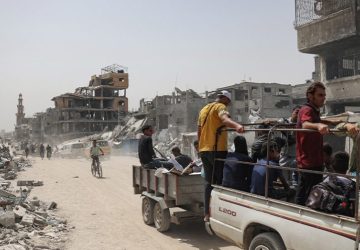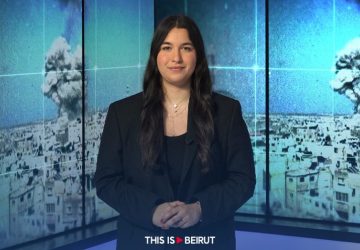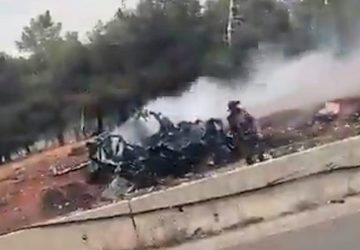Listen to the article
The Russian and Iranian imperial wars in Ukraine, Georgia and the Larger Middle East, their similes throughout the geopolitical landscapes (Taiwan, Philippines, Eastern Armenia, Syrian-Iraqi interfaces/ China, Russia-Turkey-Azerbaidjan…), and their models of governance are redefining the landmarks of renewed fascism, political violence and challenges to liberal democracy and its understanding of world order. We should add to the picture the shifting fortunes of radical Islam, its terrorist proclivities and permanent defiance towards political normalization and geostrategic stability.
Talking about equivocations when it comes to describing Iran’s foreign policy is evidence since it corresponds to an unwavering pattern of conduct with no statistical discrepancies. Far from being incidental, it reflects the inherent ambivalence of the Islamic dictatorship, its moral malevolence and self-righteousness, subversive political subtext, and unwillingness to normalize and engage the international community on its terms. This enduring political feature accounts for the inability to reform, liberalize political culture, democratize governance and foreswear subversion. Partaking of the characteristics of the communist and nazi totalitarianism, it largely explains the systemic inability to adopt reformist policies and renounce the imperial drive and connate violence. The irreformability of the Iranian regime equates with its proneness to violence, domination and imperialism. The three hallmarks are interrelated and account for their systemic nature and the politics of domestic repression and imperial warmongering.
The war in Ukraine doesn’t seem to abate and its epilogue is out of sight since the Russian autocrat is still sheltering by his faked ideological blinders and entertaining the delusions of victory over time, despite the destructive course of conflicts and the unrealistic and damaging strategic projections. The resurgent terrorism in Russia testifies to the unraveling imperial tapestry, the downgraded inner defenses and their exponential impact on national security. The psychotic nature of security exposed its vulnerabilities and demonstrated its fragility, at a time when the dictator is projecting triumphalism and invincibility. Otherwise, his ideological falsehoods and strategic myopia reflect his deliberate denial of realities and distortion of facts.
While blaming NATO and the EU for whimsical conspiracies against Russia’s geopolitical integrity, the true menaces have pinpointed, time and again, the role of Islamist movements in Central Asia. The neo-imperial ventures in Georgia (2008), Ukraine (2014-2024) and the strategic barter with Azerbaidjan and Turkey over Artsakh and the Eastern Armenian fault lines betray his denials and highlight his false strategic extrapolations. The conflict in Ukraine highlighted its critical import and incidence on Western security and the need to buttress its limes and protect its cultural canons against Russian imperial revisionism, its Chinese and Iranian handlers and associates, and the re-editing of the leftist ideological fallacies and their new woke framing.
The war in Gaza has ostensibly displayed its manipulative nature and instrumentation by Iranian power politics and their Russian and Chinese enablers. The war turned into a butchery nurtured by Hamas illusions, deadlocked military perspectives, leftist humbug, and Israeli firm determination to redress the transient national security blunders and the psychological misperceptions driven by the late operations of October 2023. The reconfiguration of the strategic landscape is mandatory since Israelis cannot afford strategic lapses and built risks on their Southern and Northern borders. The destruction of the Hamas operational platform which doubles its urban and civil layout has led to the tragic outcomes of undifferentiated combat and civilian zones. The UN resolution 2728 (March 25, 2024), which mandated a complete ceasefire and an unconditional release of Israeli hostages was flatly rejected by Hamas which emphasized its unilateral conditionalities (Khaled Mash’al statement, March 27, 2024), reasserted Iran’s political suzerainty when Ismail Haniyeh visited Tehran and stated the inevitability of a world war, and invited Muslims to join the “Al-Aqsa Flood,” overthrow Arab political regimes and more specifically the Jordanian (Mash’al, Dayf, March 29, 2024), and destroy civil peace and working statehood in Lebanon. Ironically enough, Palestinian militancy never failed throughout its history to toe the mark of Arab and Muslim power brokers’ dictates, and corroborate their moral subservience, at a time when they could have leveraged the UN resolution to rebuild an independent Palestinian platform, engage the UN and prepare for negotiations with Israel. Hamas has proven to be deliberately criminal and irresponsible when it engaged in a reckless war and overlooked the basic rights of Palestinian civilians and their physical and moral integrity.
Israel’s retaliation was swift and unmistakably retaliatory and assertive about its national security. The massacre of October 7, 2023 was a wake-up call at a time when Israeli political differences and ideological squabbles were at a pinnacle. Their counterattack demonstrated their preparedness, the searing impact of the impromptu attack and its ugly reminiscences. Still, the complexities of the military landscape, the undifferentiated combat and civil zones, the total war modus operandi, the human shields strategy and the Hamas indifference to the human and ecological costs of urban warfare, and their unwillingness to harness truce to the imperative of military disengagement to cut on the human losses and contain the humanitarian disasters. The implementation of the UN resolution has no impact if it fails to perceive the connection between the end of hostilities, the capitulation of Hamas, and the irreversible demise of the status quo ante. The truce should be tied to the withdrawal of Hamas and the unconditional release of Israeli hostages as a prelude to a permanent truce conducive to an overall scheme of negotiated peacemaking that retrieves a whole trail of mediations and finalized agreements.
The Lebanese theater inevitably intertwines with the Gaza operational theater on account of the Iranian strategy of the “unified battlefields.” The war of attrition script followed, so far, by Israeli Defense Forces is a prelude to a total war scheme that may relay it, if US and European mediations fail in their assigned objectives: enforce UN resolutions 1559 and 1701 which consecutively stipulate the disarmament of militias and armed groups (Hezbollah and its acolytes) and re-emphasize the critical importance of a security zone under the exclusive responsibility of the UNIFIL and the Lebanese army. The takeover of State institutions by Hezbollah and its Shiite rival Amal has undercut state sovereignty and relegated it to an ancillary role dictated by the putschists in power.
If Lebanon fails to uphold its prerogatives as a sovereign State, the likelihood of total war is implacable, since the systemic threats posed by the de facto extraterritoriality of Hezbollah, the Iranian political suzerainty, and the conglomerate of Islamic radicals and terrorist proxies, created and manipulated at will by the Islamic regime in Tehran, have built the case for a full-fledged war. The defeat of Hamas is likely to trigger the second stage of the Iranian subversion strategy at the regional level which advocates for the spread of destructive chaos. Iran’s proxies have become vocal in their call for generalized destabilization, and Iranian authorities are no longer secretive about it. Saudi Arabia and the Abraham Accords partners have been in total disarray since the October massacres and failed to define a clear policy course that challenges Iran’s controls and regional upper hand. Otherwise, Israel has to reset its political and military agendas, overcome its political fractiousness and reengage the peace process. So, are the Palestinians bound to restore their political autonomy and re-enter the peace dynamics?





